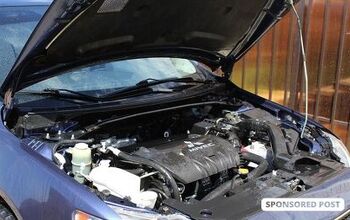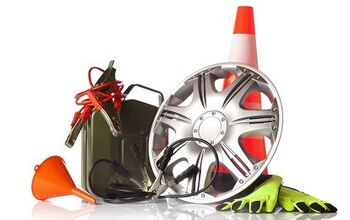5 Easy DIY Car Repairs That Can Save You Money
Dropping your car off at a professional mechanic can be costly, in terms of both time and money.
Going to a pro can leave you without your car for days if a necessary part is in short supply, and if you happen to pick the wrong time to drop off your car, you might find that there’s a long line of customers waiting ahead of you to have service performed. We’ve seen some garages with wait times as long as two weeks just to get a quote.
But even if the stars align and you manage to get your car in for servicing or repair work at an opportune time, there’s a good chance you won’t be thrilled with the final bill. Your average service garage has a number of overhead costs to recoup each month, and while the parts and chemicals themselves can cost a pretty penny, it’s often the labor charge that ends up comprising the biggest chunk of that final total.
That’s why doing your own vehicle repair work whenever possible makes sense, and can save you significant time, and money. With little more than a jack, jack stands, some basic hand tools, and the necessary shop manuals from a reputable source like eManualOnline, you’ve got just about everything you need to tackle a wide range of vehicle repair procedures.
We’ve already covered some DIY auto repair basics here, but if you’re ready to get your hands dirty and service your ride from home, here are five suggestions for simple DIY car repairs that can save you a chunk of change.
This is a sponsored article
Brake Replacement
One of the simplest, most economical car repairs you can do at home is to replace the wear items in your braking system. For most modern vehicles — which have disc brakes at all four corners — that means brake pads and possibly rotors, although some budget models still make use of drum brakes in the rear, meaning you’ll be dealing with shoes and drums on that axle instead.
Whether you’ve got disc brakes, drum brakes, or two of each, the potential savings of doing it yourself rather than taking it to the shop can be gargantuan. At the shop, you can expect to pay between $250 and $500 per axle to have new pads and rotors installed on a car with disc brakes—or significantly more if your braking system relies on more exotic materials like carbon ceramic.
Compare that to a parts cost of about $125 to $250 per axle for pads and rotors for your typical commuter car. That’s half the cost, for a job that even a beginner DIY mechanic can easily wrap up within a couple of hours.
Cost at a shop: $250 to $500 per axle
Cost to DIY: $125 to $250 per axle
Coolant Replacement
Unless you’ve got a race car in your garage, the coolant in your ride is likely a mix of anti-freeze – a water-soluble liquid that doesn’t freeze until it sees temperatures significantly below 32° F (0° C) – and ordinary distilled water. It’s a time-tested combination that flows even in frigid temperatures, which is a good thing considering your coolant is useless if it’s frozen solid. Over time, however, that coolant breaks down. As it gradually become more acidic, it loses its ability to fight corrosion, which leads to a buildup of rust that can clog coolant passageways and kill radiators.
Because of this, most automakers recommend that you flush and replenish your coolant system every two years—a job that the average home mechanic is more than capable of. That said, there are a few important things to be aware of before getting started. First, antifreeze is a highly toxic substance, and should be carefully collected and disposed of according to the guidelines in your municipality. And second, different automotive cooling systems call for different coolant chemistries. You should never mix different antifreeze types together, nor should you use anything other than the antifreeze specified by your manufacturer.
But if you’re up to the task, changing your own coolant can save you a pretty penny. On average, you can expect to pay between $100 and $150 to have a shop drain and refill your cooling system, versus around $50 or less if you do it yourself.
Cost at a shop: $100 to $150
Cost to DIY: About $50
Transmission Fluid Change
Another fairly simple DIY auto repair job is changing the fluid in your transmission. Here, the enemy isn’t just the gradual degradation of the fluid itself, but also the accumulation of tiny metal particles resulting from parts wearing against each other. Manual transmissions generally require more frequent fluid changes than automatics, but all transmissions should be drained and refilled with some regularity. Unfortunately, those newfangled “lifetime” fluids that some automakers have started to roll out don’t actually stay good forever.
The good news is that the job is usually dead simple; just support the vehicle on jack stands, crawl underneath, loosen a plug to drain the old fluid out, reinsert it, and pour the new fluid in—either through a transmission dipstick tube or a fill plug hole.
What’s more, the potential cost savings are substantial. You can expect to pay anywhere from $100 to $250 for a transmission fluid change at an independent shop or dealer service center, depending on the make, model, and age of the vehicle, versus just $40 to $100 or so if you do it yourself.
Cost at a shop: $100 to $250
Cost to DIY: $40 to $100
Suspension Component Replacement
Just as there’s more than one way to skin a cat, there are numerous methods of suspending a vehicle chassis, from short-long-arm and double-wishbone suspension arrangements to MacPherson struts, from leaf springs to torsion bars, Watt’s links, multi-links, and Panhard bars. That, plus the wide array of pricey, premium aftermarket springs, dampers, and bushings, makes it hard to predict just what it might cost to have your suspension repaired or upgraded. But seeing as you’re probably not paying yourself for labor, it stands to reason that you stand to save a pile of cash by replacing these items yourself.
Let’s take tie rods as an example. Drop your car off at the shop and you might expect to pay between $250 and $400 to replace both tie rods, whereas if you do the work yourself, you can get in and out for around $60 to $120 in parts. With all the money you’re saving, you can then drop your car off for a front-end alignment and still come out ahead.
Cost at a shop (tie rod replacement): $300 to $500
Cost to DIY: $60 to $120
Fuel Injector Cleaning
This isn’t the old days; you can’t just pull your carburetor, disassemble it on your workbench, and clean and re-jet it every time you encounter a fueling issue. Modern passenger vehicles use digitally controlled fuel injectors to spray a precisely metered quantity of fuel into each combustion chamber at exactly the right moment, and while electronic fuel injection – or EFI – has a lot of advantages when it comes to power, reliability, and fuel efficiency, injectors do occasionally clog or gum up.
Thankfully, pulling your injectors and bench cleaning them is a fairly simple job that you can do at home. Note: you’re going to be working around gasoline, so take every necessary precaution and be sure to have a fire extinguisher on standby. If you can manage that, you stand to save quite a hefty sum.
Having a shop pull your injectors and do the work can run you $60 to $100, depending on your make and model, but a good bottle of fuel injector cleaner can be found for less than $10. All you need is a way to supply the fluid under pressure to the intake orifice of the injector, and to trigger the injector to open using a common battery. And if that’s too much trouble, you can still save a few bucks simply by pulling your injectors yourself and dropping them off at the shop.
Cost at a shop: $60 to $100
Cost to DIY: About $10
Be Prepared Before You DIY
All of these jobs, no matter how easy, still require common sense, a mind for safety, and some automotive knowhow. Brake calipers aren’t as simple as they used to be; many now incorporate integrated parking brake mechanisms that require you to turn the piston as you compress it before you can install new pads. Direct injection has all but taken over from the port and single-point injection systems of yesteryear, meaning you might be dealing with significantly higher pressures as you depressurize the fuel rail. And just what voltage is required to trigger your injectors on the bench, anyhow?
Thankfully, you don’t have to know the answers to those questions off the top of your head.
eManualOnline is your source for accurate, detailed vehicle service and repair manuals—more than 1.4 million of them, in fact. Founded in 2005, eManualOnline has grown exponentially over the years to offer digital service and repair manuals covering cars, trucks, and SUVs from dozens and dozens of makes, including Audi, BMW, Ford, Hyundai, Mercedes-Benz, Nissan, Volkswagen, Volvo, and more. And while the company does provide industry-standard software used by dealerships and independent mechanics around the globe, as a DIY mechanic, you don’t have to suffer a 12-month subscription like you would with plenty of other vendors. Just find the manual you need, complete the transaction, and you’re taken straight to a download page. No muss, no fuss.
The service and repair manuals, service schedules, wiring diagrams, and diagnostics offered by eManualOnline are indispensable tools that can help you do the job, and do it right, making them an integral part of any DIYer’s toolbox.
Best of all, eManualOnline is currently offering a special 20% discount for AutoGuide readers. Just use the code AUTOGUIDE20 at checkout to get a full 20% off your purchase. Click here to shop the site, and start saving money on your next car repair.
More by AutoGuide.com Staff































Comments
Join the conversation